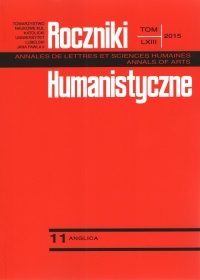Voicing of obstruents in Old Polish: An analysis of compensatory lengthening
Abstract
In this paper it is suggested that in the ancestral stages of the system, Polish obstruents were characterized by the presence of an H element responsible for voicelessness instead of an L element, interpreted phonetically as full voicing, postulated for Present-day Polish and other Slavic systems. This claim is made on the basis of a CVCV analysis of Compensatory Lengthening—a process which affected the majority of the Slavic world in the period when particular Slavic languages were evolving from Common Slavic.
References
Avery, Peter. 1996. The representation of voicing contrasts. Doctoral dissertation, University of Toronto.
Baudouin de Courtenay, Jan. 1870. O drewne-polskom jazyke do XIV-go stoletija. Lipsk.
Baudouin de Courtenay, Jan. 1984. O języku polskim. Warszawa: Państwowe Wydawnictwo Naukowe.
Bednarska, Katarzyna. 2015. Quantity in Breton and Welsh. Doctoral dissertation, Catholic University John Paul II in Lublin.
Bethin, Cristina. 1998. Slavic Prosody. Cambridge: University Press.
Carlton, Terence. 1991. Introduction to the phonological history of the Slavic languages. Columbus, OH: Slavica.
Cyran, Eugeniusz. 2010. Complexity scales and licensing in phonology. Berlin–New York: De Gruyter Mouton.
Cyran, Eugeniusz. 2011. “Laryngeal realism and laryngeal relativism: Two voicing systems in Polish?” Studies in Polish Linguistics 6: 45–80.
Cyran, Eugeniusz. 2014. Between Phonology and Phonetics. Polish Voicing. Berlin: De Gruyter Mouton.
Dunaj, Bogusław. 1966. Wzdłużenie zastępcze w języku polskim. Zeszyty naukowe Uniwersytetu Jagiellońskiego. Prace językoznawcze PAN, 17. Warszawa and Kraków: PWN.
Furdal, Antoni. 1964. “O przyczynach zmian głosowych w języku polskim.” Prace Wrocławskiego Towarzystwa Naukowego, series A, no. 94. Wrocław: Ossolineum.
Gussmann, Edmund. 1980. Studies In Abstract Phnology. Cambridge Mass.: MIT Press.
Gussmann, Edmund. 2007. The phonology of Polish. Oxford: Oxford University Press.
Hammond, Michael. 1988. “On deriving the Well-Formedness Condition.” Linguistic Inquiry 19(2): 319–325.
Harris, John. 1994, English sound structure. Oxford: Blackwell.
Harris, John. 2009. “Why final devoicing is weakening.” In Kuniya Nasukava, and Phillip Backley (eds.), Strength Relations in Phonology, 9–46. Berlin: Mouton de Gruyter.
Honeybone, Patrick. 2005. “Diachronic evidence in segmental phonology: the case of obstruents laryngeal specifications.” In Mark van Oostendorp et al. (eds.). The Internal Organization of Phonological Segments, 319–354. Berlin: M. de Gruyter.
Hyman, Larry. 1985. A theory of phonological weight. Dordrecht: Foris.
Kavitskaya, Darya. 2002. Compensatory Lengthening: Phonetics, Phonology, Diachrony. New York: Routledge
Kaye, Jonathan, Jean Lowenstamm, and Jean-Roger Vergnaud. 1990. “Constituent structure and government in phonology.” Phonology 7, 193-231.
Klemensiewicz, Zygmunt, Tadeusz Lehr-Spławiński, and Stanisław Urbańczyk. 1965. Gramatyka historyczna języka polskiego. Warszawa: Państwowe Wydawnictwo Naukowe.
Koneczna, Halina. 1965. Charakterystyka fonetyczna języka polskiego na tle innych języków słowiańskich. Warszawa: Państwowe Wydawnictwo Naukowe.
Lowenstamm, Jean. 1996. CV as the only syllable type. In Jacques Durand, and Bernard Laks (eds.). Current Trends in Phonology – Models and Methods, 419–441. Salford / Manchester: European Studies Research Institute, University of Salford.
Łoś, Jan. 1922, 1925, 1927. Gramatyka polska, cz. I. Głosownia historyczna, cz. II. Słowotwórstwo, cz. III. Odmiennia (fleksja historyczna), Lwów.
Nitsch, Kazimierz. 1911. Mowa ludu polskiego. Kraków: L. Frommer; Warszawa: E. Wende.
McCawley, James D. 1977. “Accent in Japanese.” In Larry M. Hyman (ed.). A theory of phonological weight, 261–302. Dordrecht: Foris.
Moren, Bruce. 2003. “Weight typology: An optimality theoretic approach.” Linguistic Review 20: 281–304.
Pająk, Ewa. 2010. “Middle English Open Syllable Lengthening—a CVCV analysis.” In Ewelina Mokrosz, Ewa Pająk, and Sławomir Zdziebko (eds.). Young Linguists in Dialogue. The 3rd Conference, 93–111. Lublin: Wydawnictwo KUL.
Rubach, Jerzy. (1986). “Abstract vowels in three-dimensional phonology: the yers.” The Linguistic Review 5: 247–280.
Schane, Sanford S. 1984. “The fundamentals of Particle Phonology.” Phonology 1: 129–156.
Scheer, Tobias. 1998. “Governing domains are head-final.” In Eugeniusz Cyran (ed.). Structure and Interpretation, 261–285. Lublin: Folium.
Scheer, Tobias. 2004. A Lateral Theory of Phonology: What is CVCV and why should it be? Berlin: Mouton de Gruyter.
Shevelov, George. Y. 1964. A Prehistory of Slavic. Heildelberg: Carl Winter, Universitatsverlag.
Stieber, Zdzisław. 1966. Historyczna i współczesna fonologia języka polskiego. Warszawa: Państwowe Wydawnictwo Naukowe.
Stieber, Zdzisław. 1973. A Historical Phonology of the Polish Language. Heidelberg: Universitatsverlag.
Szober, Stanisław. 1931. Gramatyka języka polskiego. Warszawa.
Szpyra, Jolanta. 1992. “Ghost segments in non-linear phonology: Polish yers.” Language 68: 277–312.
Timberlake, Alan. 1983a. “Compensatory lengthening in Slavic, 1: Conditions and dialect geography.” In Vladimir Markov and Dean S. Worth (eds.). From Los Angeles to Kiev: Papers on the Occasion of the Ninth International Congress of Slavists, Kiev, September 1983, 207–235. Columbus, OH: Slavica.
Timberlake, Alan. 1983b. “Compensatory lengthening in Slavic, 2: Phonetic reconstruction.” In Michael S. Flier (ed.). American Contributions to the Ninth International Congress of Slavists, Kiev, September 1983. Vol I: Linguistics, 293–319. Columbus, OH: Slavica.
Zdziebko, Sławomir. 2012. Issues in Scottish Vowel Quantity. Cambridge Scholars Publishing.
Copyright (c) 2015 Roczniki Humanistyczne

This work is licensed under a Creative Commons Attribution-NonCommercial-NoDerivatives 4.0 International License.





